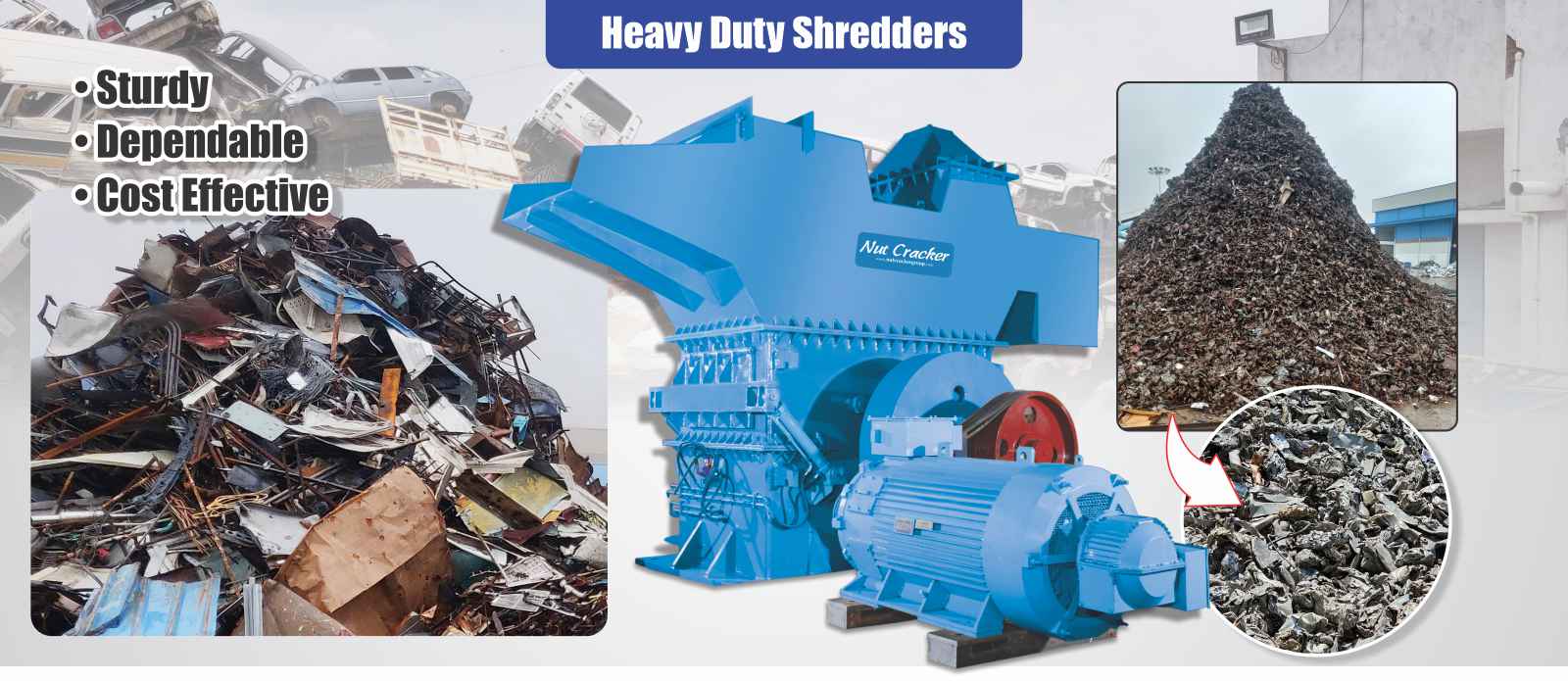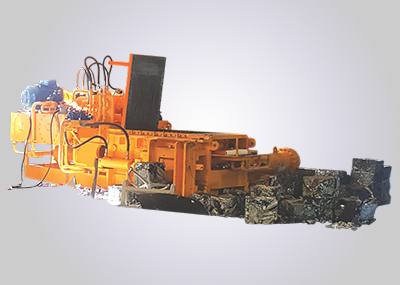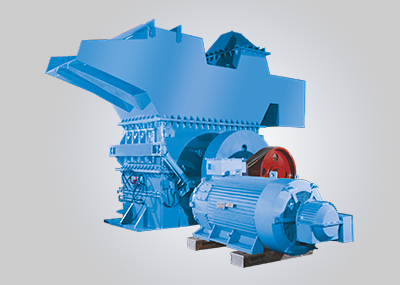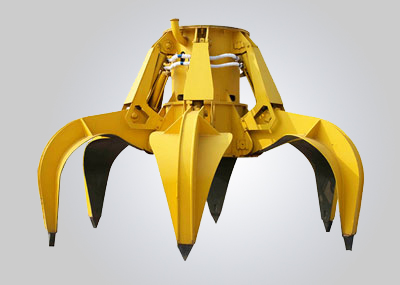
Shredders
Call : +91 9871296620
Overview
A Shredder is a machine that tears large scrap into smaller portions of higher density that are free from rust, dust & colour contents. The scrap is fragmented into small pieces by specially designed Hammers that strike the in feed scrap with very high torque. These hammers beat, shred and shear the scrap feed inside the machine until it is converted into the sheave size which is provided at the bottom structure of the machine. The hammers are made of special alloy steel for longer life and impact resistance.
Today, every business recognizes the importance of reducing the waste and treating it more responsibly, thereby reducing the carbon foot print and lowering its environmental impact. Sustainable business strategy is on everyone’s list as our world is scarce with resources and hence, we ought to bring business models that create minimum waste.
Nut Cracker understands this consensus & thus manufactures Shredders for various applications. A metal shredder with a magnetic conveyor belt can shred & segregate the ferrous and non ferrous scrap; a bio-medical waste shredder can shred the sterilized medical waste & reduce its size and a car shredder can transform the complete car into small pieces within minutes. Therefore, a few key aspects are worth considering before finalising what type of shredder best suits your requirement. They are:
- How intense is your recycling program
- What is your scrap profile
- What is the required output
- What is the expected return per ton of shredded scrap
- Does your scrap require pre-shredding
- How big is your recycling plant
- What all information you want from the equipment
- What is the expected life of the equipment & its parts
- What is the machine downtime

The shredded scrap is of great importance for the EAF as the amount of recovery and the associated costs that they incur depend greatly on the quality of the shredded scrap. Shredding is a capital intensive process & one should aim to achieve the highest recovery rate possible that ensures maximum revenue gain. Thus, after considering all such parameters, Nut Cracker manufactures shredders that produce the best results at the minimum possible costs. The Shredded steel scrap has many advantages over other types of scrap particularly when used in an electric furnace. They are:
- There is a high yield of hot metal as a ratio of input shredded scrap
- The chemistry of the hot metal is more uniform heat after heat
- The good density means there are less back charges in order to reach furnace capacity
- There is less electrode breakage
- There is longer furnace lining life
- There is less sulfur in the hot metal
- There is less phosphorus in the hot metal
- There is less electric consumption per ton of hot metal
- There is less air pollution
- There are less hot spots in the furnace
- When shredded scrap is mixed with other feed stock the shredded scrap fills the voids providing a more dense mix
- Shredded scrap lends itself to better material handling techniques

Technicals
Truly muscular and a real power house, the Nut Cracker shredder plants consist of the Main Shredder machine, Pre-Sorting Conveyors, Input / Output Conveyors, Dust collectors, Magnetic separation system, Non-Ferrous Sorting System, Trommel, Control room etc. The Shredder machine is the main part of the scrap processing plant. The in-feed scrap is fragmented here by special alloy steel made hammers striking with very high torque & continuously compressing it until it passes through the grate opening provided at the bottom structure of the unit. The shredder machine mainly consists of five parts:
- Feeding mouth (hopper)
- Main body
- Rotor
- Sheave / Grate
- Dust outlet
Feeding mouth (hopper)
The feeding mouth of the main shredder plant is kept large enough to digest sufficient quantity of scrap at a time. It has a taper plate at a very beginning to allow the material move directly into the stomach of the shredder. The mouth opening of the shredder is kept wider than the input conveyor so that the scrap easily passes through it. Likewise, the rotor assembly inside the shredder body is wider than the shredder mouth opening so as to allow effective processing of the scrap. The feeding mouth is set at such an angle that the scrap enters the shredder stomach directly thereby avoiding the “Hammer Wall Effect”, i.e. the bouncing of scrap on the top of the hammer circle.
Main body
The main body of the shredder is made out of thick cold rolled mild steel plates. The structure is reinforced with heavy ribs & stiffeners because being the most important part of the shredder machine, this is where the iron scrap rotates, shreds, gets thrown at speeds as high as 600-800 rpm by the hammers striking the scrap with high torque. Further, it also carries the weight of the entire rotor assembly. This complete structure is mounted on thick foundation plate. The foundation plate carries the entire load of the machine & the vibration effects, and transfers them to the RCC foundation. The base plate is tied to the foundation by thick bolts.
Rotor
The Rotor consists of circular supporting plates known as Discs, Hammers, Bearing blocks, Flywheels, Belt Pulley and the Main Driving Shaft. The main driving shaft is forged from thick alloy steel round duly tested on which the discs are mounted. These discs are placed on hardened bushes and are attached by tie-rods. Every part is duly machined and weight balanced with double roller taper bearings provided as per the requirement for smooth operation of the machine. The hammers are manufactured out of costly, special alloy steel cold rolled castings containing 11-14% Mn, 1.0-1.3% C, Si, P & S in the required proportions as these are very essential part of the machine. The Hammers are connected to the rotor through axles called hammer pins. The hammers are placed around the rotor in balanced positions. The discs do not take any direct blows which instead were taken by the hammers as they do their work on the anvil, thus reducing the wear and cost of maintenance. The disc design also is convenient for automatic welding for hard surfacing during maintenance periods. As the discs rotate, the hammers extend from the rotor due to inertia. When they hit a piece of scrap, the energy is transferred from the hammer to the scrap. If the scrap piece is not immediately fragmented, then the hammer is deflected backwards. It might even bounce all the way around 360 degrees but will always return to the initial position. The shredder housing contains the flying pieces of scrap and efficiently directs these pieces to the grate areas. The rate at which the scrap is fed inside the machine is in proportion with the load on the main driving motor. This leads to the controlled amount of scrap in the shredding chamber and the stress on the hammermill.
Sheave
The sheave (grate) is also an essential part of the machine. It is placed below the rotor where the scrap shreds. The sheave is made out of the same quality of steel used that is for the hammers. The sheave opening is kept just enough to maintain the required production levels with adequate density of the shredded scrap.
Dust outlet
Since, lot of rust, dust & colour contents blow up at the time of shredding, a suitable outlet is required. Therefore we have provided one big outlet at the top of shredder and another on the opposite side of the feeding hopper for their easy outflow. Further, a taper mesh on which the material shall pass is provided outside the machine so that the dust is re-collected under it.

Dust Collector Cyclone
The Nut Cracker dust collector consist of a special material handling blower, motor, bag tree with collection bag and filter. The material handling blower uses a material handling impeller. It is made fairly self cleaning, letting chips and strings slide off instead of getting trapped. The impeller turns in a spiral shaped blower housing that needs to be very smooth to minimize the disruption of airflow. The blower housing outlet then directs the collected air and chips into a bag tree where it spins in a centre separation ring. Thus, all the small & large dust particles coming out of the shredder machine enter the cyclone thereby leaving the environment clean.
Other than the main machine, the Nut Cracker shredder plants also consist of the following as its integral part:
Feeding conveyor
material slip. The conveyor consists of rubber cotton mix conveyor belt, walk way along the conveyor belt up to the mouth of shredder for any type of maintenance, electric motor and gear box.
Magnetic Separation System
An output conveyor is provided with the machine which collects all the shredded scrap that comes out of the machine. This conveyor then drops the scrap on the second magnetic drum conveyor placed in line where the ferrous scrap is segregated and all the other non-ferrous scrap moves to the third conveyor.
Non-Ferrous Sorting System
Based on requirement, Nut Cracker also supplies non-ferrous sorting systems with its shredder plants. These eddy current separators extract various non-ferrous metals, once the magnetic separation is done. Further, Nut Cracker can also provide X-ray sorting system to segregate light & heavy non-ferrous metals. This makes possible to separate aluminium & magnesium from a fraction rich in heavy metals such as copper, bronze, zinc & lead.
| Description | Units | NUT-1073/HM-600 | NUT-1073/HM-850 | NUT-1073/HM-1500 | NUT-1073/HM-2500 |
| Housing | mm | 1500 | 2000 | 2200 | 2500 |
| Power | HP | 600 | 850 | 1500 | 2500 |
| Mesh Size | mm | 125 – 150 | 100 – 150 | 100 – 150 | 100 – 150 |
| Production / hr (Approx.) | Tons | 8-15 | 18-30 | 25-45 | 30-80 |
| Machine Weight (Approx.) | Tons | 60 | 100 | 150 | 190 |
Salient Features / Benefits
- Single line / Double Line / Hybrid systems
- The shredded scrap recovered is mainly classified into three categories i.e. Ferrous, Non-Ferrous (light metals) & Non-Ferrous (Heavy metals)
- The entire process control in the Nut Cracker shredder plants can be done by the operator via PLC control buttons
- The automatic control functions provided in the Nut Cracker shredder plants enable the monitoring & control of the In-Feed materials in order to maximize the driver motor performance and to increase the average production rate
- Reliable operation and ease of maintenance of the shredding plants at a lower processing cost-per-ton of scrap produced
- Flame-proof design in case of any damage from explosion during the shredding process
- The shredder housing is designed to open hydraulically for maximum convenience during maintenance and replacement of wear parts
- Wear parts are manufactured from the work hardened steel alloys manufactured in the local foundries under strict quality control measures
- All the parts in the Nut Cracker Shredder Plants are strategically positioned in order to provide ease of access and time- efficient maintenance
- The Nut Cracker shredder plants provide the option to control the in-feed rate based on the amount of HP available in the main motor & its thermal capacity
- The operator can increase / decrease the torque as required to process bulky scrap
- Nut Cracker provide the provision of data management in its shredder plants, thereby allowing the operator to make constant improvements in its performance
- Nut Cracker shredder plants provide the data of scrap shredded per hour / per day / per month etc
- All conveyors are set up with service platform and access ladder in case of maintenance and monitoring
- Conveyor belts are made from durable materials that are anti-corrosive, flame-proof and multi-functional
- Super suction Dust Collector provided in the Nut Cracker shredder plants minimise its environmental hazards
- All the control units are provided with a separate cooling and filtering systems to ensure that the oil is kept clean under the required temperatures
The Nut Cracker shredder plants also provide the trend analysis for...
- The main motor amperage
- The temperature of motor bearings and windings
- Rotor speed
- Points of raising or lowering the rotor speed
- Temperature of the control units












